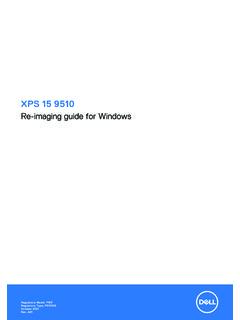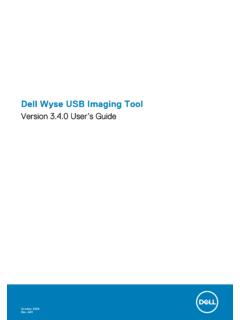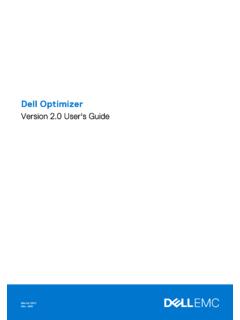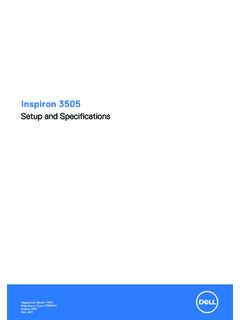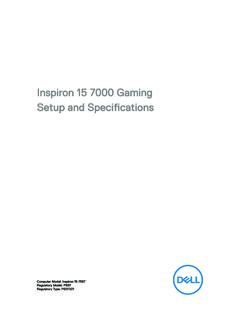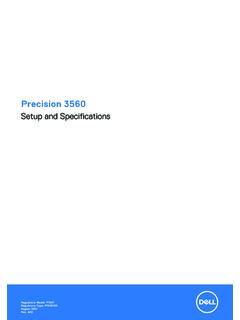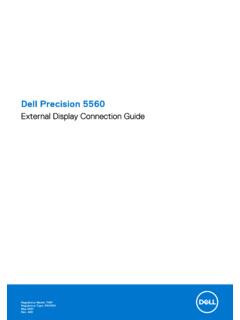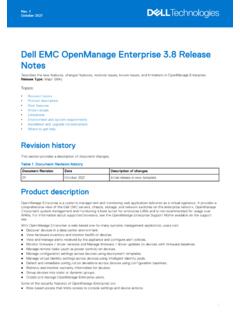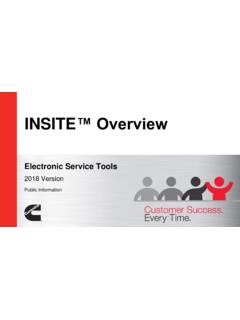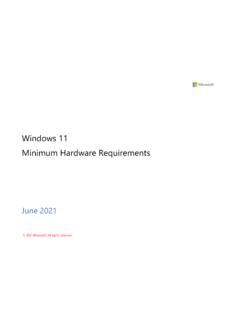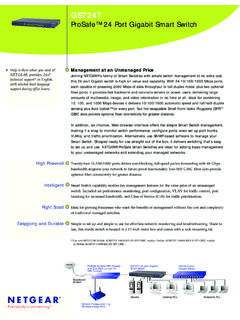Transcription of XPS 13 9310 Re-imaging guide for Windows - Dell
1 XPS 13 9310Re-imaging guide for WindowsRegulatory Model: P117 GRegulatory Type: P117G002 October 2021 Rev. A01 Notes, cautions, and warningsNOTE: A NOTE indicates important information that helps you make better use of your : A CAUTION indicates either potential damage to hardware or loss of data and tells you how to avoidthe : A WARNING indicates a potential for property damage, personal injury, or death. 2020-2021 Dell Inc. or its subsidiaries. All rights reserved. Dell, EMC, and other trademarks are trademarks of Dell Inc. or its trademarks may be trademarks of their respective 1: Installation 4 Chapter 2: 3: Order of 4: Updating or resetting the 7 Flashing the 7 Clearing CMOS Platform Module (TPM) 7 Chapter 5: Reinstalling the operating 8 Chapter 6: Reinstalling drivers and 9 Displaying drivers and applications on your 7: Reinstallation sequence for drivers and 101. Chipset device 10 Downloading and installing the chipset Critical Microsoft Knowledge Base (KB) Media-card reader and installing the media-card reader 114.
2 Intel Rapid Storage Technology (IRST).. 115. 11 Downloading and installing the Dell graphics 116. 11 Downloading and installing the Dell audio Fingerprint-reader 12 Downloading and installing the fingerprint-reader 128. Dell Power Manager (DPM)..129. Wireless Local Network (WLAN) and Bluetooth drivers and 12 Downloading and installing the WiFi and Bluetooth 1310. Dell docking 13 Chapter 8: .NET 14 Chapter 9: Getting help and contacting 15 ContentsContents3 Installation overviewCAUTION: This Re-imaging guide is designed for system administrators. Do not attempt to re-image the systemif you are not an administrator or if you are unsure of the procedures. Failure to follow instructions may result inpermanent data : Information that is provided in this guide is only applicable to computers with Windows 10 or Windows 11 : Dell recommends that you download and install the device drivers from the Dell Drivers & Downloads device drivers from a non-Dell website can cause system performance issues, corrupt operating system files, bluescreen errors, unexpected shutdowns, or infect your computer with malicious drivers must be updated when you reinstall the operating system using either a CD, DVD, USB key, or when you arefacing networking, graphics, sound or other hardware-related problems.
3 Dell recommends that you install or update devicedrivers if you have performed a factory reset of your Dell computer using the Dell Backup and Recovery application or otherfactory-reset methods. This ensures that you have the latest device drivers installed on your computer and that the devicesfunction or updating device drivers may lead to the following improvements: Increases in system performance Patched security risks Expanded compatibility Fixed device issues Support for new featuresHowever, if your computer is operating normally and there are no driver issues or updates being prompted by Windows , driverupdates may be unnecessary. Updating drivers unnecessarily may create new the importance of each driver update on the Dell Drivers & Downloads page before assessing the need to continue withan overviewIntroductionCAUTION: This Re-imaging guide is designed for system administrators. Do not attempt to re-image the systemif you are not an administrator or are unsure of the procedures.
4 Failure to follow instructions may result inpermanent data : Information that is provided in this guide is only applicable to computers with Windows 10 or Windows 11 is the process of removing all software on the computer and reinstalling the removed software. Re-imaging isrequired when software in the computer is corrupted or damaged and it can also be used as a means of removing harmful andmalicious software in your computer. This Re-imaging guide provides the steps required for Re-imaging your guide assists you in installing Dell-recommended software stack and settings, drivers, and applications, which are testedand validated on the XPS 13 9310. The installation of the listed drivers and applications as described in the guide enhances theoptimal performance of your also provides drivers and applications that are not included with the Windows operating system. These drivers are requiredto enable the following solid-state drives (SSDs): 256 GB PCIe SSD 512 GB PCIe SSD 1024 GB PCIe SSD 2048 GB PCIe SSDIt is always recommended to re-image on a newly installed operating system and not from any previous image-build.
5 EnsureBIOS settings, including SATA configurations and modes, are appropriately set and the latest drivers and applications are usedwhen Re-imaging the of reinstallationNOTE: Some drivers and application installation steps may not be applicable, depending on the configuration of thecomputer you have achieve optimal performance, install the drivers and applications in the following : Enables the operating system to be loaded into the memory and enables the initial setup process on your operating system: The operating system controls the computer's hardware to be a base on which othersoftware can operate chipset driver: Allows Windows to communicate and adjust settings on components on the system board whichincludes: Intel Chipset Device Software Driver Intel Management Engine Components Installer Intel Serial IO Driver Intel HID Event Filter Driver Intel Thunderbolt Controller Driver Intel Dynamic Tuning Driver Intel Integrated Sensor Solution Driver Intel Manageability and Security Status and communication drivers, which include: Wireless Local Area Network (WLAN) adapter driver: Enables and enhances the wireless adapter.
6 Bluetooth driver: Enables and enhances the Bluetooth adapter. Onboard Local Area Network (LAN) latest updates and drivers using Microsoft Knowledge Base (KB) updates: Microsoft updates that fix and optimize the operating system. Formore information, see Windows release reader driver: Enables and enhances the media-card Rapid Storage Technology (IRST): Enables and enhances data storage virtualization for the storage drives installedin the driver: Enhances and optimizes video performance Enables and provides additional functionality not included in the native Microsoft VGA driver, including: User-customizable power management features Portability and behavioral profiles Multiple-monitor driver: Enables and enhances the audio drivers, which include Goodix Fingerprint applications, which include: Dell Update application Dell Power Manager (DPM)36 Order of reinstallationUpdating or resetting the BIOSF lashing the BIOSIt is recommended to flash the BIOS when an update is available or when you replace the system board.
7 To flash the on your to Product support, enter the Service Tag of your computer, and then click : If you do not have the Service Tag, use the auto-detect feature or manually browse for your computer Drivers & downloads > Find it the operating system installed on your down the page and expand Download to download the latest version of the BIOS for your the download is complete, navigate to the folder where you saved the BIOS update the BIOS update file icon and follow the instructions on the CMOS settingsIf flashing your computer with the latest BIOS update results in your computer being unable to boot, a BIOS reset is the CMOS settings will reset the BIOS to factory settings. For more information about clearing the CMOS settings, seeyour computer's Service Platform Module (TPM) securityTPM must be enabled in the BIOS setup program for it to be deployed on the computer. Follow these steps to enable andconfigure the on or restart your F2 when the Dell logo is displayed on the screen to enter the BIOS setup BIOS setup program is the left pane, select Security > TPM or clear any of the following options to enable or disable it, respectively: Enabled (Default): The BIOS enables the TPM during POST and it can be accessed by the operating system.
8 Disabled: The BIOS will not enable the TPM during POST and it cannot be accessed by the operating system. TPM On: The TPM is enabled and activated. Clear: The BIOS clears the information stored in the the settings and or resetting the BIOS7 Reinstalling the operating systemThe Windows operating system is validated for use on this computer. You can reset or reinstall the operating system underdifferent scenarios. For more information about reinstalling the operating system, see the knowledge base article 000176966 attempting a reinstall of your operating system, Dell recommends that you backup all data as described in the Microsoftknowledge base the operating systemReinstalling drivers and applicationsDrivers and applications are software that enables Windows to communicate with the hardware devices and software in yourcomputer. Devices such as video and sound cards require drivers to function correctly within Windows , and enable users toadjust hardware includes drivers for most devices, but device-specific drivers may have to be downloaded and installed separately.
9 Dellrecommends that you download the device drivers for your Dell computer from Drivers & must be downloaded and installed separately. Dell recommends that you download the required applications for yourDell computer from the Dell Download drivers and applications on your on your to Product support, enter the Service Tag of your computer, and then click : If you do not have the Service Tag, use the auto-detect feature or manually browse for your computer Drivers & downloads > Find it the Windows operating system installed on your computer to get a list of the drivers and applications available on drivers and applications9 Reinstallation sequence for drivers andapplicationsDriver installation is critical after reinstalling the Windows operating system on your Dell computer. Install the drivers in thecorrect sequence for your computer to function correctly. In some scenarios, you may have to reinstall or update the devicedriver if you are encountering issues with a specific more information, see the Dell knowledge base article 000132394 at : The Windows operating system includes touchpad drivers; no other touchpad-driver installation is : The Windows operating system includes the webcam drivers; no additional webcam-driver installation is video capture or streaming, users can install webcam software available from third-party recommends installing drivers or applications in the following Chipset device softwareThe Windows operating system may not include the updated chipset device software for Dell computers.
10 The chipset devicesoftware is available on Dell s support site and installing the chipset on your to Product support, enter the Service Tag of your computer, and then click : If you do not have the Service Tag, use the auto-detect feature or manually browse for your computer Drivers & downloads > Find it down the page and expand Download to download the chipset driver for your the download is complete, navigate to the folder where you saved the chipset driver the chipset driver file icon and follow the instructions on the Critical Microsoft Knowledge Base (KB) updatesDell recommends installing all the latest available KB updates from the latest Windows Service Pack. Service packs areautomatically downloaded and installed when Windows Updates are enabled and can also be manually downloaded and installedfrom the Microsoft support site. For more information, see Windows release Media-card reader driverThe Windows operating system does not include the media-card reader driver.
